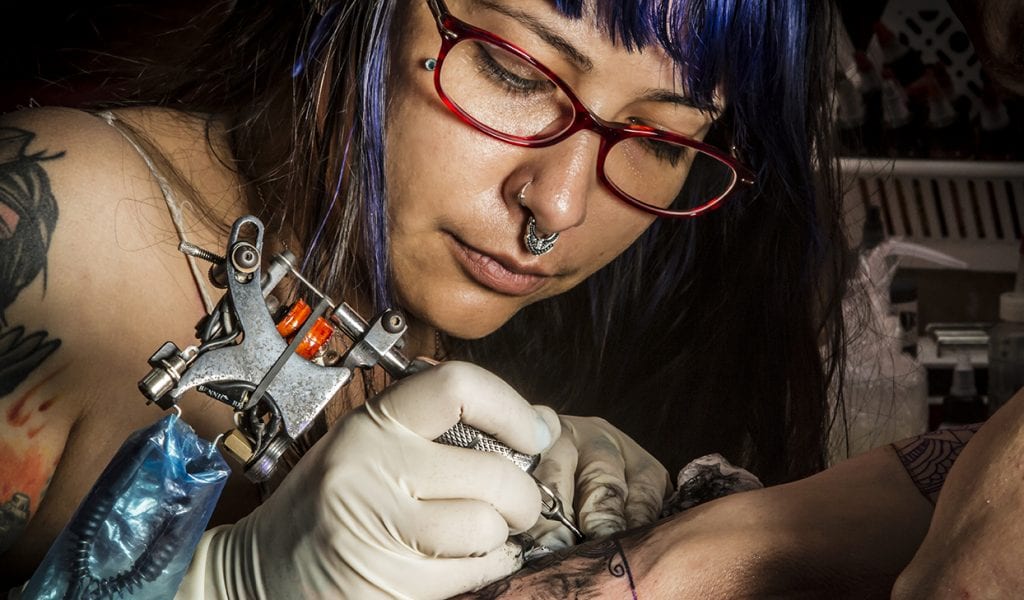Can Women be Tattoo Artists in Cuba?

by Claudia Padron Cueto (El Toque)
HAVANA TIMES — Ana tattoos some curved lines on her naked chest. She sketches some vines near the body’s sutures and then colours them in. She puts vaseline on top and blends it in. The needle vibrates wet with ink, while Ana scratches at the hollow breast. After a mastectomy, the client decided to get the artist to surround her scar with drawings.
Since 2013, Ana Lyem Laraes is the main artist at the Zenit Tattoo studio, located in the town of Santa Fe on the outskirts of Havana. In the beginning, she didn’t have much more than a needle, some ink and her friends’ willingness to be her “pioneering” clients.
Today, her business has become a reference in the city’s tattoo landscape. And she is the first and only woman here in Cuba to have her own studio. In a world dominated here by men historically, the tattoo artist has never felt underestimated by her clients because she is a woman. At the end of the day, talent has nothing to do with your sex and they know that. However, Ana says she has noticed some of her counterparts showing prejudice towards her.
“I have noticed that they have looked down at me at several competitions, as if I were an adventurous little girl who has trod on their territory. This all changes when we begin to tattoo and they see my work, then they approach you as an equal.” Ana won first prize at La caja negra, one of these events, with one of her own designs: The Mambise woman.
The Mambise woman is one of the sketches that she decided to hang up on the walls of her studio along with some flags, dozens of paint cans, antiques, photos and 15 feminist paintings “made by women to be tattooed on women.”

This year, the “GrlPwr” exhibition, which was held at Zenit Tattoo studio, broke away from the traditional and boring inertia of March 8th in Cuba, it moved away from government propaganda and cards with flowers to shout out women’s absolute sovereignty over their own bodies.
Because, in spite of a little prejudice that still exists, women showing off their tattooed bodies is becoming more and more visible on Cuba’s streets. One could claim that a business of this kind (with prices that range from 10 CUC, equal to the USD, to a couple hundred CUC) seems to be profitable with a growing clientele base which is mainly made up of young Cubans.
“This is a profitable profession for anyone who has the talent it requires, a lot of will and can afford to cover the initial investment. Then, keeping business up is hard because none of the products we use are sold here in Cuba. You have to buy everything for a much higher price than what it’s really worth.”
Used to dealing with shortages already, shortages on the national market aren’t Ana’s main fear, instead, she’s worried about the legal limbo this kind of profession is in here in Cuba.
Body art as a money-making business doesn’t figure in Cuban legislation that regulates self-employment. Right now, the Hermanos Saiz Association only registers the existence of artists under 35 years old who meet the organization’s requirements and are interested in belonging.
This legal limbo makes artists vulnerable as they can have their working materials seized at any moment and fined like what happened in 2015. Back then, Ana picked up everything she could and closed her workshop until things calmed down, but she has a bigger studio today and is risking a lot more.
Even though there are quite a few artists tattooing today (which was inconceivable a few years ago), there aren’t many women who join this world permanently and make it their sole source of income.

In a studio she shares with Che Alejandro Pando, a leader in Cuban tattoo art, Johana Cuello is another woman who is fighting for her own space in this world. Johana is 23 years old and has been tattooing others at the Toy Store Tattoo studio for two years now.
“We are left vulnerable because we don’t have legal status and we have no way of defending ourselves. We run the risk of losing everything in the blink of an eye. On the other hand, it’s also dangerous for clients. I have seen other tattoo artists who don’t abide by health and sanitation regulations and reuse needles or expose people to a cross-infection.”
Ana got her first tattoo when she was 27 years old: some letters and a face on her left arm. Then came a Zenit camera, a woman’s face, line on the outline of her shaved head… She has 20 tattoos today, spread out between her arms and legs, “and counting”, she says. They are all visible and striking, like the tattoos Johana chose for her own body.
Some prefer subtle designs, not these two. They don’t hide their inked skin. Maybe that’s why they have heard comments loaded with prejudice so many times. And that’s because quite a lot of people in Cuba associate tattoos with the marginal stereotype of prostitution, prison or drugs.
Ana is a 34-year-old woman, she graduated as an architect and is the owner of a thriving private business. Her designs can be found in neighborhoods in Havana and Mexico, where she has also inked other people’s skin. Ana and Johana also have some facial piercings, green and blue hair, and yes: both women are very proud of their tattoos.

What would be refreshing is to not be judged by my tattoos.
Here in the US it is so refreshing to meet someone, particularly young, who does NOT have a tattoo.